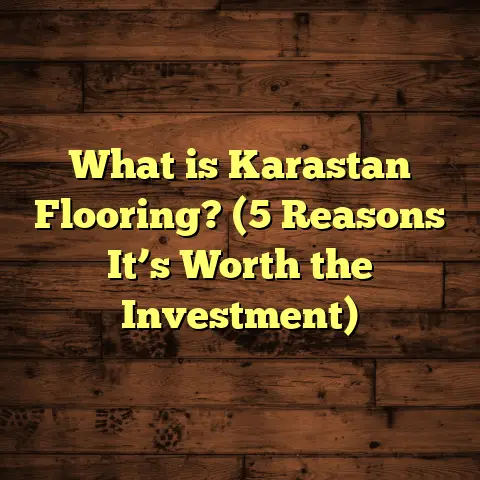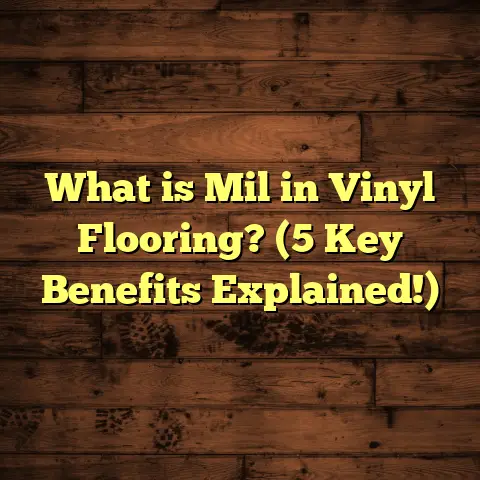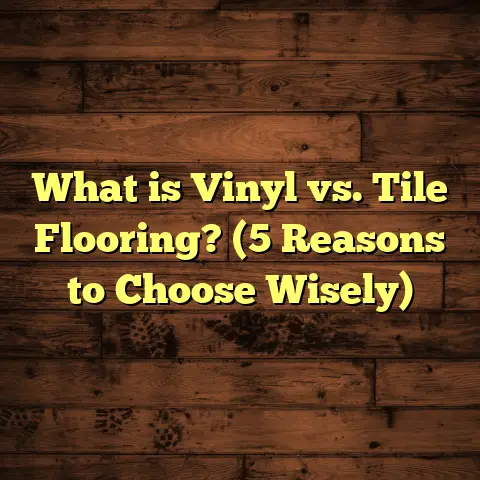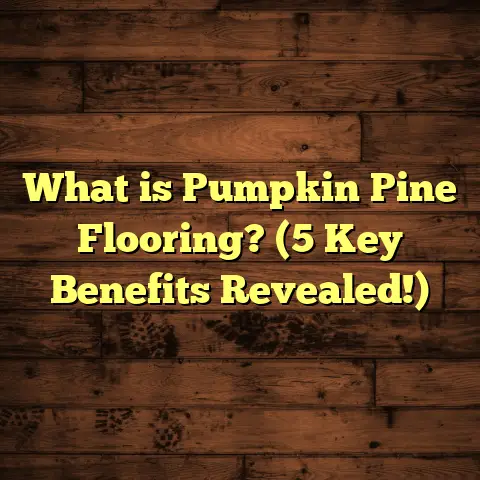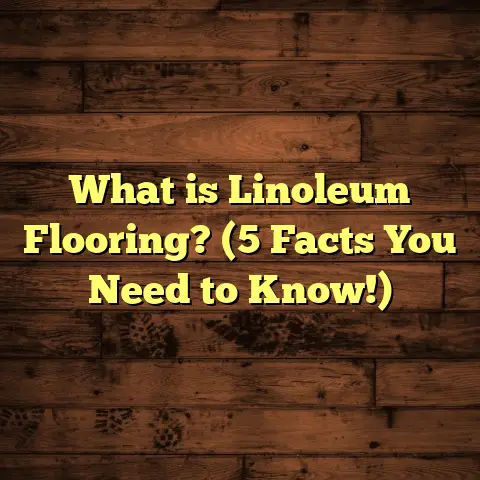What is a Buff Stick for Floors? (5 Tips for Flawless Shine)
Comfort starts from the ground beneath your feet. When I think about what makes a home truly comfortable, the first thing that comes to mind is how the floors feel and look. There’s something about walking across a well-maintained, gleaming floor that instantly changes the atmosphere of a room. It’s welcoming, warm, and just plain cozy. Over the years, as I’ve worked with countless homeowners and businesses, I’ve realized that achieving that perfect shine isn’t just about choosing the right flooring material—it’s about how you care for and maintain it. One tool that’s been incredibly useful for me in maintaining floors to a showroom shine is the buff stick.
If you haven’t come across one of these before, you might be wondering: what exactly is a buff stick for floors? How does it work, and can it really make such a difference? Let me take you through everything I’ve learned—the good, the tricky bits, and some tips that will make your floors look flawless.
What is a Buff Stick for Floors?
Let’s start with the basics. A buff stick is a handheld tool designed to polish and restore the shine on different types of floors—hardwood, vinyl, tile, and sometimes even laminate. It’s essentially a portable buffer with a handle and a rotating or vibrating head that holds a polishing pad or abrasive material.
When you use a buff stick, you move it over the floor surface to smooth out minor scratches, dull spots, and scuffs. At the same time, it applies a thin layer of polish or wax, which seals the floor’s surface and enhances its shine. The process is gentler than sanding or refinishing but still produces impressive results, especially when the floor isn’t severely damaged.
The beauty of a buff stick lies in its simplicity and versatility. It’s smaller and more manageable than large floor buffers, making it perfect for tight spots or smaller areas where big machines can’t reach. For me, it has been an ideal tool for touch-ups between full refinishing jobs or for maintaining floors that don’t need heavy-duty restoration.
Components of a Buff Stick
A typical buff stick consists of:
- Handle: Usually adjustable for comfort during use.
- Motorized Head: This rotates or vibrates to create a buffing action.
- Polishing Pad: Made from materials like microfiber, synthetic fibers, or foam. Pads vary in grit and texture depending on the floor type and polishing needs.
- Power Source: Some are corded electric models, while others run on rechargeable batteries.
How Does Buffing Work?
Buffing works by gently abrading the top layer of the floor or polish to even out imperfections. Unlike sanding, which removes significant layers of material, buffing only affects the surface finish. This means it can be done more frequently without damaging the floor itself.
When polish or wax is applied during buffing, it fills tiny scratches and creates a smooth reflective surface. This not only improves appearance but also adds protection against wear and moisture.
My Journey with Buff Sticks: Successes and Challenges
I remember my first encounter with buff sticks early in my career. I was tasked with restoring an older hardwood floor in a client’s living room who didn’t want to go through the messy, expensive process of sanding and refinishing. I decided to try buffing with a stick to see if it could bring back some shine.
The results were surprisingly good. The floor looked refreshed and glossy without the dust and downtime of sanding. That project opened my eyes to how effective buff sticks can be when used correctly.
But I quickly realized there were challenges too.
Success Stories
One memorable job involved an office lobby with vinyl floors that had become scratched and dull from heavy foot traffic. The client wanted an affordable way to improve the look without replacing the entire floor.
I used a buff stick equipped with medium-grit pads combined with a durable vinyl polish. The shine came back beautifully after just one pass. The client was so happy that they scheduled regular buffing sessions every few months to keep their floors looking fresh.
Another time, I worked on a hardwood floor in a residential space where pets had left small scratches all over. Buffing helped smooth out those marks and restored the floor’s luster without having to refinish the entire surface.
Challenges Encountered
However, buffing does have its limits. One challenge I faced was when I tried to buff out deep scratches on hardwood flooring. The buff stick could only do so much; those scratches required sanding before polishing could be effective.
Another issue is knowing how often to buff. Over-buffing can cause problems like build-up of polish layers that peel or look cloudy. Sometimes clients want their floors shiny all the time but don’t realize that too much polishing can backfire.
I also had an experience where I accidentally used an aggressive pad on soft wood floors, leaving swirl marks that were tough to remove. That taught me how important it is to match the pad grit with the floor type.
Five Tips for Flawless Shine Using a Buff Stick
Want to get your floors shining like new? Here are five practical tips I’ve picked up from years of experience:
1. Pick the Right Polishing Pad
Pads come in different materials and abrasiveness levels. Choosing the correct pad for your floor type is critical.
- For hardwood floors: Use soft, fine-grit pads to avoid scratching.
- For vinyl or tile: Medium-grit pads usually work best.
- For heavily scuffed areas: You might need an initial rougher pad followed by finer ones.
I’ve found that using pads designed specifically for your flooring material helps prevent damage and ensures better results.
2. Clean Before You Buff
It might sound obvious, but many people skip this step. Dirt or grit left on your floor can get ground into the surface during buffing, causing scratches.
I always vacuum thoroughly and mop with an appropriate cleaner before starting to buff. This step also helps the polish adhere better to the floor.
3. Use High-Quality Floor Polish or Wax
Not all polishes are created equal. Some are designed specifically for use with buff sticks and offer longer-lasting shine and protection.
I tend to recommend products from well-known brands that have been tested on different surfaces. Avoid cheap polish solutions that can leave residue or dull quickly.
4. Don’t Rush Through the Process
Take your time during buffing. Move at a steady pace and cover small sections at once with overlapping passes.
Moving too fast reduces polish effectiveness and can lead to uneven shine or missed spots. I aim for consistent coverage so the whole floor gleams evenly.
5. Maintain Your Floors Regularly
Buffing isn’t just a one-time fix—it should be part of an ongoing maintenance routine.
For high-traffic areas, quarterly buffing combined with regular cleaning keeps floors looking their best year-round. Lower traffic areas might only need buffing twice a year.
How Data Helps Me Plan Flooring Projects
When I plan projects involving floor maintenance or installation, budgeting is key. Getting cost estimates right helps me avoid surprises for clients and myself.
One tool I rely on heavily is FloorTally. It’s an online calculator that factors in local labor rates, material costs, room size, and even waste factors to give precise cost estimates.
For example, when budgeting for buffing jobs, I enter room dimensions and choose flooring type in FloorTally. It calculates how much polish and pad replacement I’ll need plus labor costs based on area size.
This saves me from guessing or underestimating costs—which has happened before when I didn’t plan carefully! Having accurate data helps me manage client expectations and keeps projects running smoothly.
Case Study: Buff Stick Success in a Commercial Setting
A recent project involved a retail store with over 1,200 square feet of tile flooring that customers had worn down over time. The client wanted their floors shining again but didn’t want to replace tiles due to cost concerns.
After cleaning thoroughly, I used my buff stick with medium-grit pads and applied a commercial tile polish suited for high-traffic areas.
The whole job took around four hours over two days. Using FloorTally beforehand gave me a clear estimate of materials and labor needed—helping the client budget confidently.
Post-buffing feedback was positive: customers noticed cleaner-looking floors immediately, and maintenance staff reported less buildup needing daily cleaning.
The client now schedules professional buffing every three months as part of their maintenance plan—a smart move considering how much wear their floors get!
Unique Insights From My Experience
Through years of using buff sticks, I’ve noticed some things that aren’t always obvious:
- Humidity Matters: Polishing in high humidity or damp conditions can cause polish to dry unevenly or streak. I always check weather conditions before scheduling my jobs.
- Pad Care is Critical: Dirty or worn pads don’t polish effectively. Washing pads regularly (if washable) or replacing them keeps results consistent.
- Don’t Ignore Floor Type: Some softer woods need gentler polishing. Vinyl sometimes requires special polishes designed for plastic surfaces.
- Buff Stick Speed Settings: Many models let you adjust speed. Slower speeds reduce risk of damage but take longer. Faster speeds work well on tougher surfaces but need careful handling.
Real Data Points on Buffing Floors
Here are some numbers from my projects and research:
- Buffing can extend hardwood floor life by up to 20% by sealing out dirt/moisture (source: Floor Care Institute).
- Properly maintained floors require refinishing far less often—typically every 7-10 years instead of 3-5.
- Average time for buffing 1,000 sq ft ranges from 2-5 hours depending on floor type and condition.
- Material costs for polishing products average $0.10-$0.25 per sq ft when factoring in polish and pads.
- Labor rates vary widely—$30-$60 per hour locally—but tools like FloorTally help estimate accurately based on region.
Common Questions About Buff Sticks
Q: Can I use a buff stick on laminate floors?
A: Generally no—laminate has a protective wear layer that doesn’t respond well to polishing. Buff sticks might damage laminate surfaces instead of shining them.
Q: How often should I buff my hardwood floors?
A: For residential homes with moderate traffic, once or twice yearly is usually enough. High-traffic commercial spaces may benefit from quarterly buffing sessions.
Q: Will buffing fix deep scratches?
A: No—deep scratches require sanding or refinishing. Buff sticks are best for light scratches, scuffs, and general maintenance.
Q: Do I need special training to use a buff stick?
A: It helps! While basic use is straightforward, knowing correct pad selection, pressure application, and polish types improves results and avoids damage.
My Personal Story With Buff Sticks
I recall one particular client who was worried about their old hardwood floors in their family room. They’d tried cleaning products but could never get rid of dull spots left by years of wear from kids and pets. They were hesitant about costly refinishing options due to budget constraints.
After inspecting their floors, I suggested using my buff stick as an alternative approach. We cleaned thoroughly first then did a careful buffing session using soft pads and high-quality polish. The transformation was remarkable—the floors regained their warmth and glow without sanding away any wood. The client was thrilled they got such great results quickly at a fraction of the cost they’d feared.
That project reminded me how understanding tools like buff sticks—and using them wisely— can make big differences even on shoestring budgets.
If you’re thinking about trying a buff stick yourself or want advice about which model fits your flooring needs, just ask! I’m happy to share insights from my hands-on experience so your floors get that comfortable shine you deserve. Floors aren’t just surfaces—they’re part of what makes a house feel like home, and keeping them looking their best is easier than you might think with the right tools and know-how.
Have you ever tried polishing your floors? What worked or didn’t? Let’s chat about what might be best for your space!
